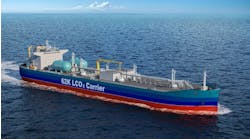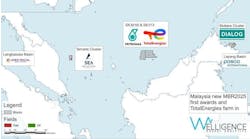Jeremy Beckman • London
Statoil hitting production targets
Strike action this summer by Norwegian rig crews should not dent Statoil's 2004 production figures, so said acting CEO Erling Overland during a financial presentation in London last month. A prolonged protest might bring repercussions next year, however, if rig unavailability curtailed development drilling plans.
Snøhvit, Statoil's most sensitive project in terms of schedule overruns, has not been affected so far, due to in-built flexibility in the drilling program. Since June, when the company announced that capex had escalated by NKr4.6 billion above the original estimate, construction progress has been good, Overland maintained. By way of a contrast, he cited the development plan for the Norne satellites in the Norwegian Sea, which was submitted and approved by the authorities during the same period. "This was quite an achievement," he said.
Other recent milestones include a 38% jump in Statoil's gas production over the comparable period in 2003, led by rising demand from European customers. Another positive has been the performance of the Vigdis extension project in the North Sea. Here recoverable reserves have been upgraded 66% to 93.7 MMboe, with the break-even price dropping to $7/boe. The capex forecast, meanwhile, is now 17% lower – around NKr0.5 billion than the original estimate.
"This represents a good example of how we can develop marginal fields close to our existing infrastructure," he said.
null
Norway's 18th licensing round earlier this year generated 46 awards. Statoil, as usual, was the biggest recipient, securing four Norwegian Sea operatorships and partnerships in three other licenses in this province, plus two in the North Sea.
"This gives us a good base for increased exploration activity and discoveries in the years to come," he said. Statoil expects to drill its first 18th round wells in 2005, possibly using the Eirik Raude harsh environment semi on an extended charter foll- owing drilling commitments in the Barents Sea this winter. Seismic acquisition is already under way on some of the new Norwegian Sea blocks, which include the Gjallar North exploration prospect.
De Ruyter moving ahead
A rare oilfield development is shaping up in the Dutch North Sea. Petro-Canada has awarded an engineering and procurement services contract for its De Ruyter project, in blocks P10 and P11b, to UK contractor Amec, which also undertook front-end engineering design studies earlier this year. Petro-Canada has opted for a platform comprising a steel gravity storage base supporting an integrated production deck, with oil offloaded directly to shuttle tankers. Gas will be exported through a new 33-km, 8-in. pipeline. A similar concept was adopted for the Hanze field in the same sector, which Petro-Canada acquired from BP in 2002 as part of a package of former Veba-owned assets. Yards in northern Europe and the Far East are thought to be competing for the deck and base.
Subsea phase 3 for Captain
ChevronTexaco has kicked off a third phase of its heavy oil Captain development in the UK's Outer Moray Firth, which came onstream in 1997 via an FPSO and a wellhead protection platform. Under a second phase in 2000, targeting reserves in the so-called Area B, an 18-slot subsea drilling template and a bridge-linked platform (BLP) were added.
Phase 3, focusing on Area C in the east of the reservoir, will involve drilling two manifolded subsea production wells linked by flowlines to the Area B manifold 3-km distant. Produced fluids will then be transported through the existing pipeline network to the BLP for processing. The BLP itself will undergo preparatory modifications next year. Start-up is expected in 3Q 2006.
Also in the central North Sea, UK independent Dana Petroleum has become outright operator of the 2002 Barbara gas-condensate discovery in block 23/16c. Dana bought out Amerada Hess' interest, leaving it with 80% – Eni UK holding the remainder. Recoverable reserves are estimated conservatively at 120 bcf and 4 MMbbl; however, a hydrocarbon-water contact was not encountered in the discovery well, so there is potential for greater upside. Dana plans to investigate with an appraisal well in 2005. BP's Everest and ETAP centers are seen as possible hosts for a subsea tieback.
Dong takes stakes West of Shetlands
Mærsk has received the go-ahead from the Danish Energy agency to further develop the Valdemar field with a new platform, bridge-linked to the Valdemar A installation. Eight horizontal producer wells will be drilled into the Lower Cretaceous reservoir, starting next summer.
Danish state oil company Dong, which is about to be privatized, has signaled its ambitions to branch out of home territory by taking ConocoPhillips' stakes in three UK production licenses north and west of the Shetlands, and 30% of Faroese license F003. One of these contains Total's Laggan discovery from the mid-1980s, which was recently appraised in the lead-up to a possible field development. In return, ConocoPhillips receives part of Dong's share in Norwegian license PL273.
According to Dong's E&P President Soren Gath Hansen, "The area is one of the most promising in northern Europe with respect to the possibility of finding oil and gas, and besides the well on Laggan, we expect this year to participate in three exploration and appraisal wells in this area. The discoveries will make a good contribution to our future gas production, but will require new process facilities and pipelines. We are thus talking about a long-term investment. According to present plans, it will be five to 10 years before the discoveries go onstream."




